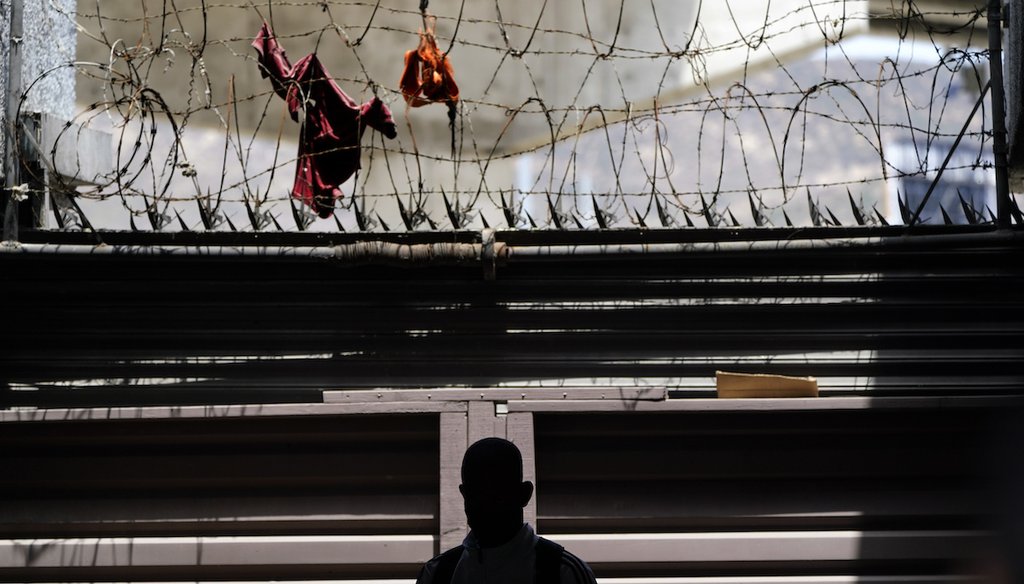Stand up for the facts!
Our only agenda is to publish the truth so you can be an informed participant in democracy.
We need your help.
I would like to contribute

A migrant from Haiti waits with others at a clinic for migrants in Tijuana, on Monday, May 23, 2022. The Supreme Court has ruled that the Biden administration properly ended a Trump-era policy forcing some U.S. asylum-seekers to wait in Mexico. (AP)
If Your Time is short
-
The Supreme Court ruled that the Biden administration could end a Trump-era program called “Remain in Mexico” that sent some migrants seeking asylum back to Mexico to await their immigration court proceedings.
-
But the Supreme Court also limited the power of lower courts to make rulings that would immediately affect immigration policy.
-
Lower courts now have to make new rulings on whether the Department of Homeland Security followed the law with new limits in place.
The Supreme Court ruled 5-4 that the Biden administration could end "Remain in Mexico," a Trump-era program that sent some migrants seeking asylum to Mexico to await their immigration court proceedings.
The decision is a victory for the government, but the ruling also limits the power of lower federal courts in other immigration cases, leading immigration advocates to call it a double-edged sword.
The Trump administration created the Migrant Protection Protocols or "Remain in Mexico" program in January of 2019 via a memo issued by the Department of Homeland Security.
The Biden administration suspended all new enrollments in January 2021. By June 2021, DHS published a memo terminating the program. But in August 2021, a federal court ordered the administration to implement it again, after Texas and Missouri sued DHS. The case made it up to the Supreme Court.
Here’s what Chief Justice John Roberts said in the majority decision, and what it means for the future of the program.
The lower courts said the Biden administration broke immigration law by rescinding the "Remain in Mexico" program, but the Supreme Court disagreed.
Customs and Border Protection usually has two options when immigrants entering the country illegally are taken into custody: they can be detained or released while they wait for their court hearing.
The law says an immigrant "shall" be detained while their immigration case is pending. But DHS has never had the capacity to detain all immigrants awaiting proceedings. Instead, DHS prioritizes which immigrants to detain.
Under immigration law, Congress also says the government "may" return an immigrant back to the country they came from to await their immigration proceedings.
The appeals court ruled that since the law says the government "shall" detain all immigrants and detention capacity is insufficient, the government must then return to Mexico all immigrants that can’t be detained. But the Supreme Court disagreed.
Congress wrote that the government "may" return immigrants which does not mean they must. In the decision, Roberts pointed out that "no administration has ever used" that section of the law "to return all such aliens that it could not otherwise detain."
The "Remain in Mexico" program is dependent on Mexico’s agreement to take back immigrants returned to its country. Not all of the asylum seekers sent to Mexico are Mexican nationals, many of them are from Central America.
Following the lower court’s ruling that DHS had to reinstate the program, the Biden administration began negotiations with the Mexican government. In December 2021, DHS implemented a series of changes to the original Trump-era program.
The Biden administration expanded the group of people included in the "Remain in Mexico" program to all Western Hemisphere nationals, excluding Mexicans, as opposed to nationals of Spanish-speaking countries and Brazil. But the program also included more individual exceptions.
The Supreme Court said Biden had the authority to do that because the presidency is charged with conducting foreign policy.
"The Court has taken care to avoid ‘the danger of unwarranted judicial interference in the conduct of foreign policy,’" the majority opinion said.
In June 2021, DHS issued a memo ending the "Remain in Mexico" program. The lower courts ruled that, based on administrative law, the reasons for ending the program were inadequate.
The court sent the issue back to DHS, at which point the agency had two options. It could either provide a more detailed explanation for ending the program, or it could take a new agency action to terminate it.
In October, the Secretary of Homeland Security, Alejandro Mayorkas published a new memo ending the program.
The lower courts said Mayorkas had selected the first option of providing a more detailed explanation to the June memo. The Supreme Court disagreed and said the lower courts should now decide whether the October memo, as a separate agency action, violated the Administrative Procedure Act, a law describing how federal agencies can make and enforce regulations.
Historically, when people believe an immigration policy violates immigration law, they can sue the government, which initiates a court case. However, these cases often take a long time, so the person or group suing can ask the courts to either stop or restart the policy if it is causing immediate harm. This is called an injunction, said Stephen Yale-Loehr and immigration law professor at Cornell Law School.
This is what happened in the "Remain in Mexico" case. DHS ended the program, and Texas sued the government. The lower court issued an injunction ordering the federal government to reinstate the policy while the case was under litigation.
But the Supreme Court ruled that lower federal courts do not have this power.
This decision allows lower courts to rule on whether an immigration program is illegal but limits their ability to take action to provide relief, said Andrew Arthur at the Center for Immigration Studies, a think tank that favors low immigration levels.
Groups that favor immigration found the Supreme Court ruling to be a double-edged sword. It allowed the Biden administration to rescind "Remain in Mexico," but it took away the power of lower courts.
"In the future, it may make it harder for advocates and others to challenge unlawful immigration policy decisions," said Aaron Reichlin-Melnick at the American Immigration Council, a pro-immigrant nonprofit.
The Supreme Court ruled that the Biden administration could end the "Remain in Mexico" program, but it also sent the case back to the lower courts to decide whether the administration had followed the correct administrative procedures. And at the same time, the Supreme Court limited the power of lower courts to order the government to end or restart an immgiration program.
If the lower court finds the government violated administrative law, it could ask Homeland Security to vacate, or invalidate the memo terminating the "Remain in Mexico" program. This would leave the previous memo in place, meaning the program would have to restart.
Whether this action is within the powers of the lower courts remains to be seen, experts said.
This case will likely stay in litigation for some time and might even make its way back to the Supreme Court in the next term, according to Arthur.
"From a strictly rule of law issue, it raises a lot more questions than answers," he said.
It will likely be some time before the "Remain in Mexico" program is officially terminated, according to the Biden administration.
"We need to wait until the Supreme Court's decision is actually communicated to the lower court, to the federal district court in the northern district of Texas. And once that occurs, the district court should lift its injunction that is preventing us from ending the program. So we have to wait several weeks for that procedural step to be taken," Mayorkas said July 3 on ABC’s "This Week."
More than 70,000 migrants have been sent to Mexico under the "Remain in Mexico" program, about 7,000 of them since the Biden administration resumed the program in December 2021 under the court order.
After the program ends, many migrants will still not be allowed into the U.S. to seek asylum because Title 42, a public health policy intended to mitigate the spread of COVID-19, remains in place. This policy has been used since March 2020 to send immigrants back to Mexico without giving them a chance to apply for asylum.
"The actual impact at the border will be significant for the thousands of people who had already been sent back to Mexico will now have a chance to reenter," Reichlin-Melnick said. "For migrants newly arriving at the border, very few of them have any realistic chance of being put into the program in the first place."
Our Sources
Phone interview with Aaron Reichlin-Melnick, policy director at the American Immigration Council, July 5, 2022.
Phone interview with Andrew Arthur, resident fellow in law and policy at the Center for Immigration Studies, July 6, 2022.
Phone interview with Stephen Yale-Loehr, professor of immigration law practice at Cornell Law School, July 6, 2022
Department of Homeland Security, Policy Guidance for Implementation of the Migrant Protection Protocols, Jan. 25, 2019
U.S. Supreme Court, Biden et al. v. Texas et al., June 30, 2022
Department of Homeland Security, Termination of the Migrant Protection Protocols Program, June 1, 2021
PolitiFact, Courts are still debating the legality of DACA, June 29, 2022
Department of Homeland Security, Termination of the Migrant Protection Protocols, Oct. 29, 2021
Britannica, Administrative Procedure Act, accessed July 7, 2022
Legal Information Institute, Vacatur, accessed July 7, 2022
ABC, Congress must pass legislation to fix 'broken immigration system': Sec. Mayorkas, July 3, 2022
Transactional Records Access Clearinghouse, MPP (Remain in Mexico) Deportation Proceedings—All Cases, accessed July 7, 2022
Department of Homeland Security, Migrant Protection Protocols Cohort Report, June 2022
American Immigration Council, The "Migrant Protection Protocols", Jan. 7, 2022














































